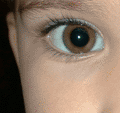 There is nothing quite as annoying as pictures that aren't sharp, or pictures where the focus isn't right. For example, you want to take a shot of an insect in a flower, but you end up with a blurry bee and the grass behind it in sharpest focus. Or you want to take a picture of a group of friends, but the camera decides to focus on some stupid object in the foreground instead. Or nothing is sharp at all, and all you got from your shiny new 7-megapixel digicam is seven million garbage pixels. Obviously, that's no fun, and I consider a camera's ability to consistently take sharp pictures with the focus in the right areas as one of the most important features. During my seven year tenure as Digital Camera Magazine's publication director, I've dismissed many cameras that just didn't seem to be able to focus right, and loved those that could.
There is nothing quite as annoying as pictures that aren't sharp, or pictures where the focus isn't right. For example, you want to take a shot of an insect in a flower, but you end up with a blurry bee and the grass behind it in sharpest focus. Or you want to take a picture of a group of friends, but the camera decides to focus on some stupid object in the foreground instead. Or nothing is sharp at all, and all you got from your shiny new 7-megapixel digicam is seven million garbage pixels. Obviously, that's no fun, and I consider a camera's ability to consistently take sharp pictures with the focus in the right areas as one of the most important features. During my seven year tenure as Digital Camera Magazine's publication director, I've dismissed many cameras that just didn't seem to be able to focus right, and loved those that could.
What is so special about autofocus systems? What makes some good and others virtually useless? What can you do to get the sharpest pictures from your camera? In order to get some answers we need to look at how autofocus systems work.
First, there is a difference between "active" and "passive" systems. Active ones shoot out some sort of signal and then measure how it bounces back from subjects. Passive ones, primarily used in SLRs, analyze an image and then draw conclusions from that.
Polaroid (remember them?) originated one of the first active systems back in 1986. It used high frequency sound and then computed the distance of the object. Sound, of course, has many limitations and those systems easily became confused. Today, most cameras use infrared active systems instead. That is also not foolproof and generally works best within a distance of perhaps twenty feet or so. There are different technologies. Some measure the time it takes for the light to bounce back from subjects. Others determine how much is bounced back. Yet others use triangulation methods.
As stated above, "passive" systems are only passive insofar as the camera does not emit any active signal. Instead it analyzes the picture and then moves the lens back and forth until it determines the picture is sharp. Passive systems use horizontal or vertical (or both) CCDs that analyze contrast and then draw conclusions from that.
If your camera doesn't seem to do any focusing at all, that's because it may not have autofocus. Some inexpensive cameras still use fixed-focus lenses.
With all this technology, why does autofocus fail us so often? Primarily because the camera can't read your mind and doesn't know what to focus on. How is it supposed to know you want a picture of your girlfriend instead of the Grand Canyon in the background? Or vice versa? It can't.
Why can't you just look at the LCD and see if the camera focuses on the right object? Primarily because the LCDs on most digital cameras today are too small or do not have enough pixels to really show sharpness. Sometimes a picture looks good even on playback, but when you look at it on the computer screen it's blurry anyway.
With all of those problems, it's no surprise that the camera industry has come up with many different systems and solutions. Most modern digital cameras have different autofocus systems you can select. Different companies use different terminology, but it generally boils down to center or multipoint focus.
Center autofocus means the camera looks only at the center of the picture and focuses on that and nothing else.
Multipoint autofocus means the camera looks at multiple points in your frame, determines their distance, and the computes a "best-fit" focus. Some cameras will latch on to one of the areas and show you which one by displaying little rectangles on the LCD.
Focus lock can be a big help. It lets you focus the camera on your subject and lock in by holding the shutter half depressed, but then frame the picture differently without the focus changing.
Focusing problems can be human error or they can be technology errors.
Human error happens when someone doesn't spend time learning the auto focus system in their camera. They simply use the default setting and eventually dismiss the camera for "shooting bad pictures" when, in fact, they could have picked the right focusing method.
Technology problems occur when the camera sensor doesn't have enough light or can't find enough contrast to figure out what to focus on. Many cameras have illuminator lights that shoot a brief beam of light onto a dark areas so that the AF mechanism can find something to lock onto.
Most major camera makers have their special blend of electronic herbs and spices to make things work. Sony, for example, uses a "Hologram AF Illuminator, which projects a very low power laser pattern and then reads the contrast between the pattern's edge and the subject for very precise focusing. Minolta's AREA-AF system analyzes objects within the focus area and guesses which are people. The system's algorithms process all data to make sure it will focus on a human and not some extraneous subject. And there are many other technologies that improve autofocus.
So learn how to use autofocus. It's a great investment of your time.








